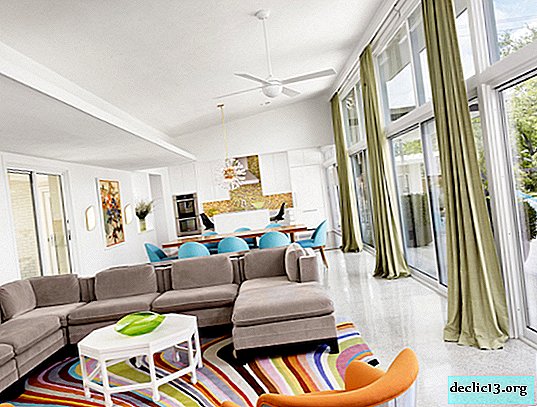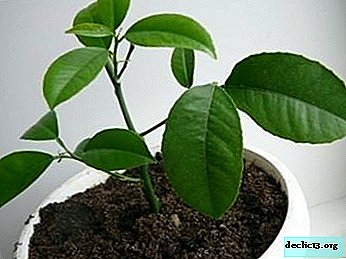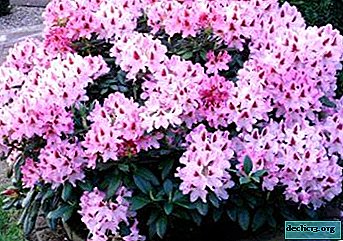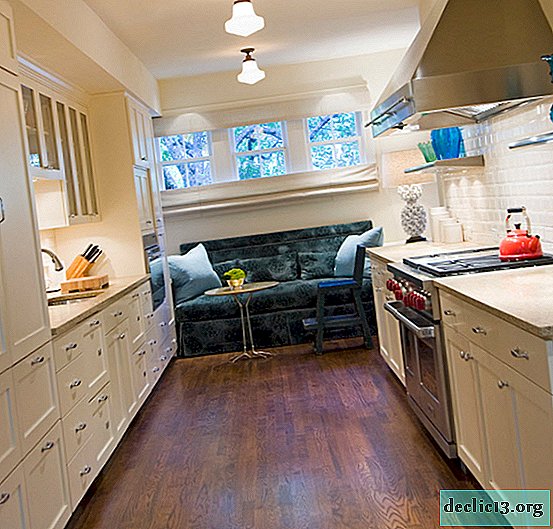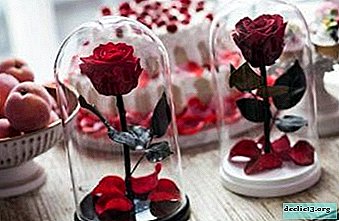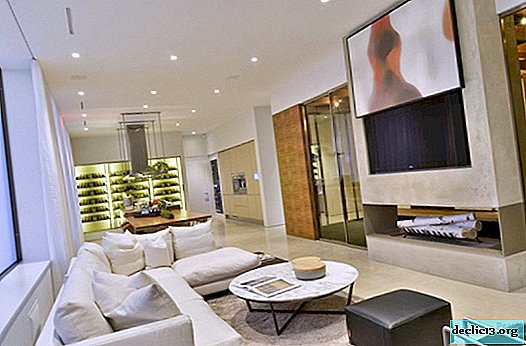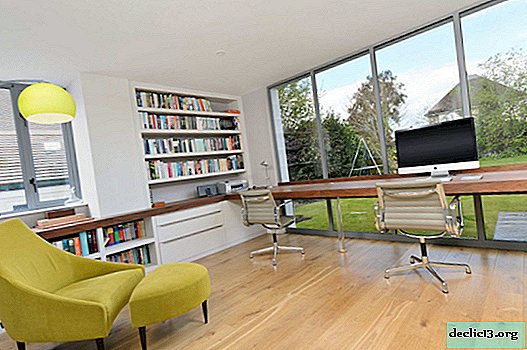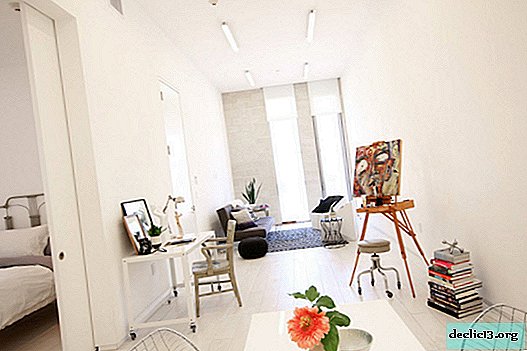Lush flowering lobelia Sapphire: description, photo and features of care
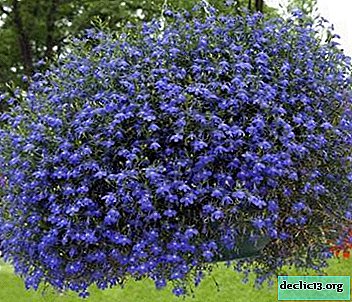
Lush rugs scattered among the greenery delight the eye and give the garden a sophisticated charm. From the first summer days to autumn frosts, the lobelia is completely covered with miniature flowers of delicate shades: blue, pink, sky blue, violet, purple.
Lobelia sapphire is an interesting decorative culture that is suitable for growing at home and in the open ground. It features a long and lush flowering. In the Russian climate, the winter does not tolerate well, so you have to take the plant to the house for the winter, otherwise it will die in the cold.
Appearance
Lobelia sapphire is an ampel plant, whose homeland remains Central America. It is grown there as a perennial culture, but in the harsh climate of Russia, it is an annual. Since the plant is ampelous, its stem is not able to hold on its own, therefore, it will be necessary to prepare a supporting structure or plant a flower in a pot.
They apply culture for decorative design of a personal plot, garden paths, arbor walls, garden houses. The height of the bush is 15-20 cm, although there are some species that reach the mark of 50 cm.
This variety is distinguished by bright leaves and spectacular blue-violet inflorescences of a spike-shaped form.Photo
Next, you can see the photo of the flower:



Landing Features
Since Lobelia sapphire is a culture that grows poorly, it is better to sow seeds in February-March.The plant does not have special requirements for soil. It will take root on loams with a neutral pH level. If you use too nutritious soil, then lobelia will give fewer flowers and more greenery. For this plant, ready-made soil mixtures for seedlings of flowering crops are suitable or prepared personally.
It is necessary to combine in equal proportions such components:
- garden land;
- vermiculitis;
- sand.
The substrate for lobelia sapphire should not contain humus. Disinfect the soil before use - treat with a special tool, a weak solution of potassium permanganate or boiling water.
Seeds
Pros and cons of the method
Method Advantages:
- a plant derived from seeds adapts better to climate, tolerates frost and drought more easily;
- simplicity of landing;
- the possibility of obtaining a large number of seedlings.
Disadvantages of the method:
- it is impossible to get a plant with varietal characteristics of a "parent";
- flowering occurs in the 2-3rd year after planting.
How to choose seeds?
 The first step is to purchase planting material. It is of two types:
The first step is to purchase planting material. It is of two types:
- Granulated pelletized. These seeds are already prepared, so that they can be planted immediately in peat tablets, avoiding picking. The granules also contain a special composition that allows planting material to shoot as quickly as possible.
- Untrained. There are a lot of them in the package, so sowing is laborious. Such seeds do not guarantee the quality of seedlings, and plants have yet to be pickled in separate containers. Preparation of seeds involves dusting them with fungicide by adding powder on the tip of the label.
Procedure
For planting events, it is necessary to prepare flat containers, then fill with a substrate. Sapphire Lobelia Planting Procedure:
- Since the seeds are very small, they can be combined with sand. Distribute them rarely on the surface of the soil, without deepening and not sprinkling with earth.
- If peat tablets are used as soil, then planting material should be arranged as follows: sharpen the tip of a match, moisten with water, immerse seeds with its help in the soil.
- After sowing, cover the container with plastic wrap. Keep seedlings indoors at a temperature of 18-20 degrees.
- Open the film every day for ventilation. Moisten the soil from time to time using warm and settled water.
- Shoots will appear in 10-14 days. From this time, remove the film 2 times a day, with each time increasing the duration of ventilation by 10-20 minutes.
- Since the sprouts are very tender, the first time they are moistened by spraying using a spray bottle.
- As soon as 2-3 real leaves are formed, then dive, planting the plants in separate containers. To do this, choose the strongest instances. The pot should have no more than 3-5 sprouts. The procedure must be carried out very carefully, as the plants are very fragile.
- To grow seedlings at a temperature of 15-18 degrees. It is also necessary to maintain soil moisture, as the leaves will curl due to lack of moisture. But waterlogging will lead to the development of mold.
The duration of such a walk will be for the first time 20-30 minutes, and every day it should be increased by 10-15 minutes, bringing to 24 hours. After hardening, seedlings can be planted in open ground.
We offer you to see the form on how to properly plant the lobelia Sapphire seeds:
Cuttings
Pros and cons of the method
 Pros of the method:
Pros of the method:
- access method;
- preservation of plant variety;
- flowering occurs next year.
Cons of the method:
- cuttings are poorly rooted;
- cuttings are difficult to grow.
- the cuttings must be planted very carefully to avoid breakage.
Training
To prepare the planting material, you need to dig a bush in mid-autumn, before frosts come. Then transplant it into a pot, put in a cool place and only occasionally water it. With the onset of spring, new shoots form. Cut them off, place in a Kornevin solution for 2 hours, and then in water. After 2-3 weeks, the first roots will appear.
Procedure
When the stalk gave the first roots, then you can proceed to planting, I will use the following recommendations:
- Place drainage (expanded clay) at the bottom of the container.
- Add soil from above, filling it with a 1/3 part pot.
- Place the cuttings, add the remaining soil, tamp and water the soil with warm water.
- Install the young plant in a cool and well-lit area.
Outdoor cultivation
For planting, choose a well-lit place.
Overly fertile soil should be avoided, as this will cause the plant to actively build up green mass, and there will be no flowering. Loose sandy or loamy soils, but with the presence of humus, are excellent.Landing in open ground is performed as follows:
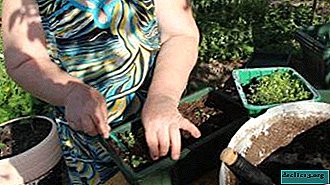 Dig a plot, prepare pits 20-30 cm. Cross lobelia with an earthen lump.
Dig a plot, prepare pits 20-30 cm. Cross lobelia with an earthen lump.- Top up the soil, cover the roots, and slightly compact the top layer of the earth.
- Plant 3-4 sprouts in one hole, then water carefully.
- Between plants, maintain a distance of 15-20 cm.
Lobelia sapphire is resistant to diseases and pests, especially if all agrotechnical rules are strictly observed. Among the diseases, the danger is:
- root rot;
- powdery mildew;
- spotting;
- rust.
To combat these fungal infections, fungicides must be used. Of the pests, the most dangerous remain:
- aphid;
- scale insects;
- slugs.
Wintering
In regions with warm winters (lowering temperatures to -29 ° C), perennial lobelia can winter in the open ground. Shoots should be cut off, leaving about 5 cm in length. Mulch with peat, fallen leaves, the thickness of the covering layer should be at least 20 cm.
Care
- Topping. As soon as the first flowering has passed, it is necessary to carry out preventive pinching of the plant. This will allow the young bush a little "rest" and form new side shoots. As a result of this increases the splendor of the plant and future flowering. The essence of the procedure is to remove all the stems at the base.
- Lighting. Lobelia sapphire is a photophilous plant. It needs to be planted in a well-lit place, where there are no drafts and wind. But only direct sunlight should be absent.
 Watering. Perform watering 1-2 times a week. You need to pour water strictly under the root. Use necessary warm and settled liquid. The plant can not be wetted from above. This will lead to burns on the leaves. If you grow lobelia in containers, then watering is best done daily. Then the drying out of the soil and the wilting of the crop can be prevented. If the summer is very hot, then water the bushes 2 times a day, in the evening and in the morning.
Watering. Perform watering 1-2 times a week. You need to pour water strictly under the root. Use necessary warm and settled liquid. The plant can not be wetted from above. This will lead to burns on the leaves. If you grow lobelia in containers, then watering is best done daily. Then the drying out of the soil and the wilting of the crop can be prevented. If the summer is very hot, then water the bushes 2 times a day, in the evening and in the morning.- Top dressing. Timely application of nutrients will give the plant a boost of energy for lush flowering. Fertilize 2 times a month using mineral formulations for flowering plants. But only here it is important not to overdo it, especially with nitrogen top dressing. Otherwise, there will be lush foliage, but flowering will become sparse and ugly.
- Pot. For the plant, you need to pick up a pot of small sizes, since the root system is poorly developed. Since lobelia is an ampel plant, it is best to grow it in hanging pots. Diameter of the container is 16-20 cm.
- Pruning. Once flowering has ended, you need to trim the plant, leaving a length of at least 5 cm from the soil. Such timely pruning will extend the flowering for the entire spring-summer period.It is not necessary to make pruning too sparse, since with each subsequent time the branching and flowering density increase.
Often, gardeners to increase the splendor of a bush use the full pruning of the upper stems, but not more than 5 cm. This is a great way to increase the splendor of not only the bush itself, but also flowering.
Lobelia sapphire is a beautiful flowering plant that is great for growing at home and in the open. In terms of growing lobelia is not capricious, rarely sick and blooms profusely. So, every grower dreams of planting lobelia in his personal plot.

 Dig a plot, prepare pits 20-30 cm. Cross lobelia with an earthen lump.
Dig a plot, prepare pits 20-30 cm. Cross lobelia with an earthen lump. Watering. Perform watering 1-2 times a week. You need to pour water strictly under the root. Use necessary warm and settled liquid. The plant can not be wetted from above. This will lead to burns on the leaves. If you grow lobelia in containers, then watering is best done daily. Then the drying out of the soil and the wilting of the crop can be prevented. If the summer is very hot, then water the bushes 2 times a day, in the evening and in the morning.
Watering. Perform watering 1-2 times a week. You need to pour water strictly under the root. Use necessary warm and settled liquid. The plant can not be wetted from above. This will lead to burns on the leaves. If you grow lobelia in containers, then watering is best done daily. Then the drying out of the soil and the wilting of the crop can be prevented. If the summer is very hot, then water the bushes 2 times a day, in the evening and in the morning.
